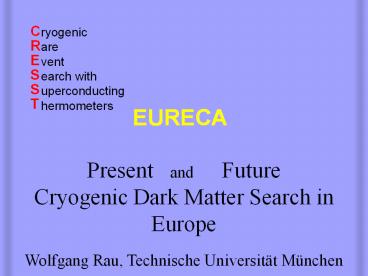Present and Future Cryogenic Dark Matter Search in Europe - PowerPoint PPT Presentation
Title:
Present and Future Cryogenic Dark Matter Search in Europe
Description:
if high QF applies for WIMP recoils: results comparable to EDELWEISS (10-6 pb) Light yield ... Different targets (WIMP signature) Collect European competence ... – PowerPoint PPT presentation
Number of Views:30
Avg rating:3.0/5.0
Title: Present and Future Cryogenic Dark Matter Search in Europe
1
Present and Future Cryogenic Dark Matter
Search inEurope
C R E S S T
ryogenic are vent earch with uperconducting hermom
eters
EURECA
EURECA
- Wolfgang Rau, Technische Universität München
2
- CRESST
- Max-Planck-Institut for physics (Munich)
- Technical University Munich
- University of Oxford
- Laboratori Nazionali del Gran Sasso
- University of Tübingen
- University of Warwick
- EDELWEISS
- CEA-Saclay DAPNIA/DRECAM
- CRTBT Grenoble
- CSNSM Orsay
- FZK/Univ. Karlsruhe
- IAP Paris
- IPN Lyon
- Laboratoire Souterrain de Modane
EURECA CERN MPIK (Heidelberg)
...
3
ILIASIntegrated Large Infrastructures for
Astroparticle Science
- Financed by EU
- Infrastructure for astroparticle physics in
Europe (not complete, but a good start) - Contains different structures
- Networks (Dark Matter, Double Beta, Underground
Science, Gravitational Waves, Theory) - Joint Research Activities (Double Beta, Low
Background, Gravitational Waves) - Transnational Access (Underground laboratories)
- 12 Countries, 20 Contractors / 140 Institutes,
gt 1000 scientists
- Forum for discussion of future plans in Europe
4
Overview
- CRESST
- Technique
- Status
- Next Future
- EDELWEISS
- Technique
- Status
- Next Future
- EURECA
- Idea
- Plans
- Status
5
CRESST Technique
- Target CaWO4
- Cylindrical, ?/h 4 cm
- Mass 300 g
- Light output 1 (gs)
- Light detector
- 30 ? 30 ? 0.4 mm Si
- Thresholds
- Phonons 2 keV
- Light 20 eV
- 2 keVee
- Discrimination 12 keV
6
CRESST Technique
Quenching
- Nuclear recoil less light than electron recoil!
- Different light yield for different nuclei (O,
Ca, W)?
- Two experiments to measure Quenching (so far room
temp.) - Neutron scattering
- Ion beam
- Both indicate less light for heavy nuclei
Additional support from data
?-band
?-band
- a-band between g- and n-band
- recoiling nuclei from a-decay
n-band
(O)
W-band
7
CRESST Technique
8
CRESST Status
- Spring 2004 2 months run with 2 detectors
? sensitivity limited by neutrons ? if high QF
applies for WIMP recoils results comparable to
EDELWEISS (10-6 pb)
9
CRESST Status
- Since April 2004 upgrade
- Install neutron moderator
- (30-50 cm PE, 11 t) µ-veto
- Increase number of readout channels (4 ? 66)
- Enlarge target mass (600 g ? 10 kg)
Shielded cryostat
PE neutron moderator Plastic scintill. m-veto
10
CRESST Next Future
- Finish major work by beginning of 2005
- Restart with few detectors
- Install new detector holder late spring
- Increase target mass to 10 kg within 2005
- Situation in Gran Sasso not clear
- (major construction work expected influence on
CRESST so far unknown)
11
EDELWEISS - Technique
Target cyl. Germanium crystal, 320 g ? 7.0 cm,
height 20 mm (beveled)
Thermal NTD ( 20 mK)
12
EDELWEISS - Technique
- Thresholds
- Heat 0.4 2 keV Ionization 1.1 1.5
keV Analysis - Ion. trigger 20 30 keV
- Phon. trig. 15 keV
- Resolution
- Heat 0.6 2 keV _at_ 10 keV
- 2 4 keV _at_ 122 keV
- Ion. 2 3 keV _at_ 122 keV
13
EDELWEISS - Status
2003 Data (3 new detectors)
- Ion. trigger
- 20 kg d
- Thr
- 20/30 keV
- 3 events
- Phonon trigger
- 22 kg d
- Thr
- 15 keV
- 18 events
- 1 coinc. (n-n)
2000 2003 62 kg d, 40 events (only 3 for
30100 keV)
14
EDELWEISS - Status
NbSi sensors for athermal phonons
Outer electrode
NbSi meander
- NbSi metal-isolator transition (high R)
- 2 surfaces covered (ionization heat sensors)
- Two-component signal
- Thermal (energy)
- Athermal (surface discrimination)
- Successful test with 200 g modules in EW I
- 90 rejection
- 50 efficiency
15
EDELWEISS Next Future
Edelweiss II _at_ Modane (4800 m w.e.)
- Aim for sensitivity improvement?? 100
- Installation started 04/04 expected to finish
summer 05 - 1st phase 21 NTD detectors (320 g), 7 NbSi
detectors (400 g)
16
EDELWEISS Next Future
- Large new cryostat
- low activity
- inverse geometry
- up to 120 detectors
17
EURECA
uropean nderground are vent search
with alorimeter rray
E U R E C A
18
EURECA Idea
- Next generation DM search to explore most of SUSY
parameter space - Cryogenic experiments very promising
- Target mass in the 1 ton range
- Different targets (WIMP signature)
- Collect European competence
19
EURECA Plans
- Discriminating cryogenic detector to reach a
sensitivity ? 10-10 pb for coherent interaction - Better sensitivity for spin-dependent interaction
- Design study to investigate requirements and
technical challenges - Detector development (larger modules, better
discrimination, other targets) - Optimal shielding strategies
- Background reduction (handling/cleaning) and
modeling (Monte Carlo simulations) - Cryogenics, electronics, cabling, DAQ
20
EURECA Plans
- Structured in Working groups
- Detector Development
- Low Radioactivity
- Neutron Background, µ-veto and Shielding
- Cryogenics
- Cabling
- DAQ
- Underground site issues
21
EURECA Status
- Letter of Intent to ApPEC summer 2004
- Start proposal process September 2004
- Present Proposal to ApPEC January 2005
- Present Proposal to Funding Agencies
- Start work 2005/06 ???































